I’ve tried many trap exercises over the years, and I can definitely say that cable exercises offer something special that you can’t get with dumbbells or barbells.
Constant tension.
With cables, your traps stay under tension throughout the entire range of motion, which is impossible with free weights.
The result? Faster growth and better muscle development.
Here, you’ll discover the 7 best cable trap exercises (including 3 you’ve probably never seen before). These exercises target ALL THREE regions of your trapezius (Upper, middle and Lower).
Know More: 20 Best Trap Workout and Exercises for Mass and Strength
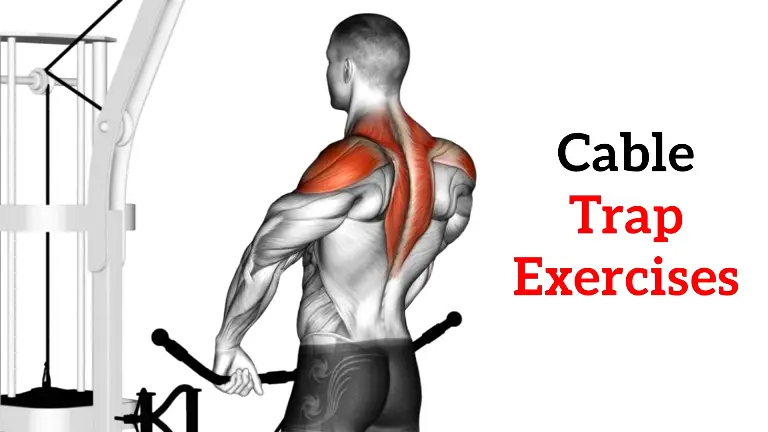
- 7 Best Cable Trap Exercises For Mass and Strength
- 1. Cable Shrug
- 2. Cable Upright Row
- 3. Face Pull
- 4. Cable High Row
- 5. Seated Cable Row
- 6. Cable Y Raises
- 7. Cable Reverse Fly
- What is the Trapezius Muscle?
- FAQs
- How do you train traps with cables?
- Are cable shrugs good?
- How do I Build My Trap Muscles With a cable?
- Do cable rows work traps?
- References
7 Best Cable Trap Exercises For Mass and Strength
Some of the best cable trap exercises to add to your workout routine include:
1. Cable Shrug
The cable shrug is a variation of the traditional shoulder shrug and is recognised as one of the most effective exercises for developing the upper trapezius.
The shrug is an isolated vertical scapular elevation. Your arms remain straight, and all the motion comes from lifting your shoulders directly upward, not backward (a common mistake).
Cables ensure tension at both the top and bottom, maximising time-under-tension (TUT).
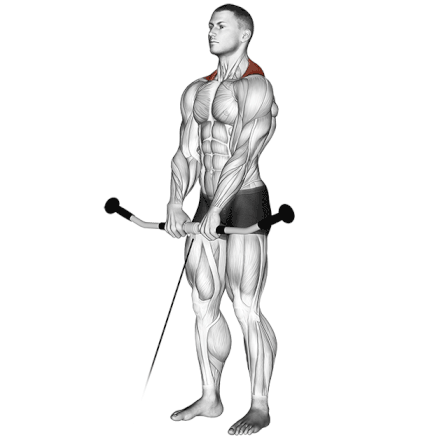
How To Do
- Stand facing a cable machine with a straight bar attachment (my preferred) or two D-handles connected to the low pulleys. Ensure you have enough space to stand tall.
- Grab the bar with an overhand grip, hands slightly wider than shoulder-width. If using D-handles, grab one in each hand.
- Stand tall with your feet shoulder-width apart. Keep your chest up, shoulders slightly pulled back, and look straight ahead.
- Start by shrugging your shoulders straight up to your ears. Move only your shoulders and traps—keep your arms straight and avoid bending your elbows or using your biceps.
- Squeeze your traps hard at the very top of the movement.
- Slowly and with control, lower the weight back down to the starting position.
- Repeat for the desired number of reps.
Tips
- Prevent from rolling your shoulders, as this is an incorrect form and can result in injury.
- Inhale when you lower the weight and exhale when you lift.
- Try adding a pause at the top of your shrug.
- Always select a weight that gives you full body control throughout the movement.
2. Cable Upright Row
Cable upright row is incredibly effective for hitting the upper traps and the side and front deltoids.
The upright row involves shoulder abduction (lifting the arm away from the midline), which trains the side delt, and scapular elevation (a shrugging motion), which trains the upper trap.
However, this is a big issue. From my perspective as a trainer, it’s an exercise that often gets a bad rap—and for good reason. Done incorrectly, it can cause shoulder pain. But with strict form and awareness, it can be a valuable tool.
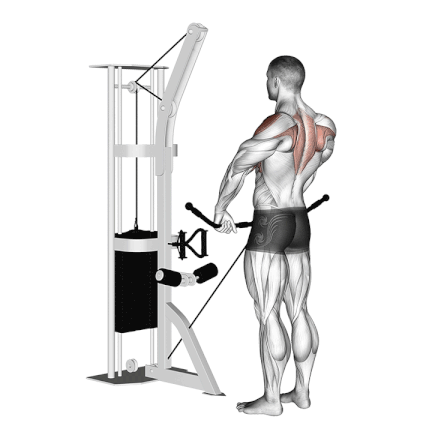
How To Do
- Stand facing a cable machine with a straight bar attachment on the low pulley. You can also use a rope or two D-handles for potentially more comfort.
- Grab the bar with an overhand grip with a wider grip (hands closer to shoulder-width apart), which reduces some internal rotation, making it safer for some. I often recommend starting with a wider grip.
- Stand tall with your feet shoulder-width apart. Your arms should be extended downwards.
- Begin the movement by pulling the bar straight up towards your chin
- STOP PULLING WHEN YOUR ELBOWS REACH SHOULDER HEIGHT OR JUST BELOW.
- Slowly and with control, lower the weight back down to the starting position.
Tips
- Bend slightly at the knees and stand with feet shoulder-width apart.
- DO NOT pull the bar all the way up to your chin if it means your elbows go significantly above your shoulders. Your upper arms should ideally not go past parallel to the floor.
Related Post: Upright Barbell Row: How To Do, Muscle Worked & Benefits
3. Face Pull
If I had to select a single exercise that I consider essential for nearly every client, it would undoubtedly be the Face Pull. This exercise effectively targets the rear deltoid and the trapezius muscles, particularly the middle and upper regions.
- As you pull the rope back towards your face, your upper arms move horizontally away from the front of your body. This action primarily trains the rear deltoids.
- Simultaneously, you should pull your shoulder blades together towards your spine. During this motion, the middle Trapezius and Rhomboids power train.
This is one of my favourite exercises. It helps me build a bigger trap and rear delt.
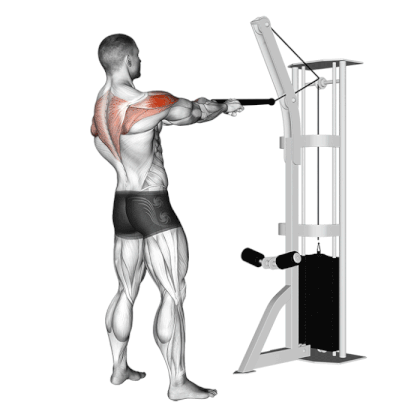
How To Do
- Set up a cable machine with a rope attachment at roughly eye level or slightly higher (this is a good starting point; you can experiment with height later).
- Grab the rope with an overhand grip (palms facing down/towards the floor), placing your thumbs against the ends of the rope.
- Step back from the machine until the weight stack is slightly off the pins, creating tension. Your arms should be extended forward.
- Assume a stable stance (feet shoulder-width, maybe one slightly forward). Keep your chest up, your shoulders relaxed down (not shrugged up initially), and your core engaged.
- Pull the rope directly towards your face, aiming for a point between your nose and forehead.
- As you pull, actively retract your shoulder blades. Continue pulling until the ends of the rope are pulled past your ears, and your hands are near the sides of your head.
- Then, slowly return the rope to the start position and repeat for reps.
Tips
- Stand straight with your feet in a comfortable, balanced stance.
- Think about trying to pinch your shoulder blades as tightly as possible when pulling weight toward your face.
- Your upper arms should be straight out to your sides, with elbows bent
4. Cable High Row
Half kneeling high cable row rope is a tremendous exercise that effectively works many muscles, including the shoulder, back, wing, and middle and lower trapezius muscles.
Using this exercise gives people with shoulder issues an exercise to get the benefits of rows.
In addition, face pull is one of the most effective corrective exercises for compensating for poor posture and shoulder dysfunction.
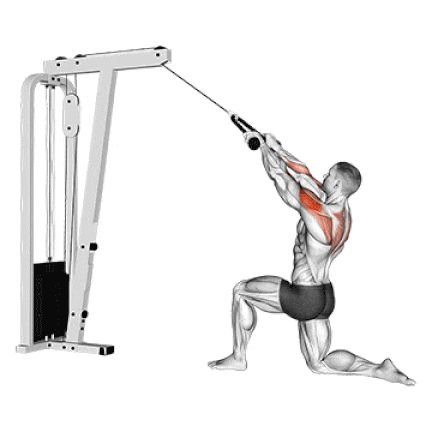
How To Do
- Set up a cable machine with the pulley set high, with the rope attachments
- You can perform this seated, kneeling, or standing – kneeling often provides great stability and allows for a good stretch. Let’s describe kneeling.
- Grab it with a neutral grip (palms facing each other).
- Reach up and grab the attachment. Lean back slightly from your hips.
- Initiate the pull by driving your elbows downwards and back. Focus on squeezing your shoulder blades together and pulling them down your back.
- Slowly return to the starting position. Repeat 10-15 reps.
Tips
- Don’t lean backwards to pull the weight towards you.
- Retract your shoulder blades as you pull, squeezing the upper back.
- Experiment slightly with the pulley height to see where you feel the contraction most effectively in your mid/lower back.
5. Seated Cable Row
The Seated Cable Rows are a fundamental horizontal pulling exercise. It’s a compound movement that effectively targets the entire back musculature.
Squeezing the shoulder blades together is the most effective way to exercise the rhomboid and mid- and lower traps muscles.
You can do it using different attachments.
It can be done with wide and narrow grips.
- A pronated (overhand) grip tends to target the upper and middle trapezius,
- Meanwhile, a neutral (thumbs up) grip hits the middle and lower trapezius.
- A supinated (underhand) grip switches the focus to the latissimus dorsi.
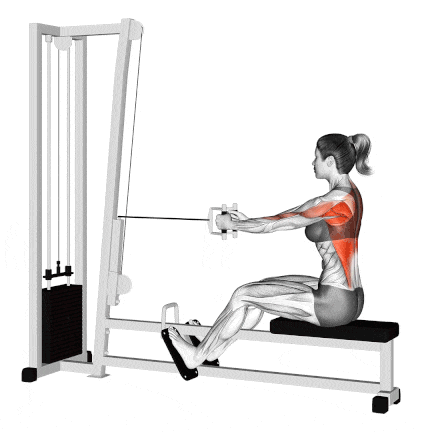
How To Do
- Sit on a seated cable pulley rowing machine with legs slightly bent and feet supported against the crossbar.
- Take hold of the handles with your arms extended and back stretched.
- Pull the handles to come as close to the lower chest/abdomen as possible.
- Thrust your chest out while pulling with your body in an upright position.
- Slowly return the handle to the starting position.
Tips
- Pause briefly when the handles are close to the chest and squeeze your upper back muscles, bringing the scapulae closer.
- Keep your knees slightly bent to avoid knee and lower back pressure.
- Remember, a rounded back is a wrong back. Keep it straight at all times.
- Keep your upper back stationary; don’t move your upper back, back, and forth.
6. Cable Y Raises
The Cable Y Raise is a highly effective isolation exercise for strengthening the rear delts, lower traps, and rotator cuff stabilisers.
Y-raises involve the lower trapezius for scapular upward rotation and depression, aided by the serratus anterior for rotation and protraction. The posterior deltoids and sometimes supraspinatus perform shoulder abduction/flexion. The middle trapezius may assist with retraction, and the rotator cuff stabilizes the joint.
You can do this exercise one arm at a time, but training them equally will help you avoid any muscle imbalances and keep everything in harmony.
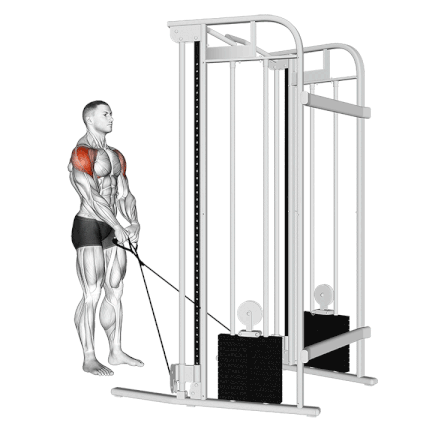
How To Do
- Set up a cable machine with the pulleys set as low as possible. Attach a single D-handle to each cable.
- Grab a D-handle in each hand using an overhand grip (palms facing down).
- Stand facing the cable machine. Take one or two steps back to create tension, ensuring the weight stack is slightly off the pins.
- Your arms should be extended downwards and slightly in front of you. Maintain a slight forward lean from your hips.
- Keep your arms relatively straight (a slight bend in the elbow is fine). Raise both arms simultaneously, making a letter ‘Y’ shape.
- Raise your arms until they are roughly in line with your torso (or slightly above, if comfortable and controlled)
- Avoid shrugging your upper traps excessively towards your ears; the focus is on upward rotation and depression of the scapula’s lower tip.
- Slowly lower your arm back to the starting position. Do 10-12 repetitions for 3 sets.
Tips
- Raise your arms in a wide “Y” shape—roughly at a 45° angle from your torso
- Avoid shrugging your shoulders up to your ears. Keep them relaxed and down.
7. Cable Reverse Fly
The cable reverse fly is an isolation exercise targeting the upper back and shoulder muscles, specifically the rear deltoids, rhomboids, and trapezius muscles.
The cable machine provides steady and consistent resistance throughout the movement, unlike dumbbells, which can vary in tension.
Experiment with neutral, overhand, or underhand grips to target different muscle fibers in your trap.
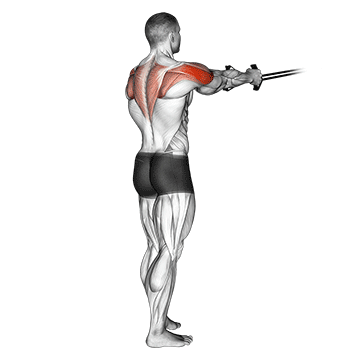
How To Do
- Set the pulleys to the desired height, usually around chest level.
- Stand in the center of a cable apparatus. Position your feet shoulder-width apart for stability.
- Grab the left cable handle in your right hand and the right side handle in your left hand.
- Pull your arms out to the sides in a controlled and deliberate manner.
- Squeeze your shoulder blades together as you do the move.
- Pause for a moment at the peak contraction.
- Slowly lower your arms back to the starting position. Do 10-15 repetitions per set.
Tips
- Keep a slight bend in your elbows during the exercise; do not lock them.
- Pull slowly so that you are always in control of the weight.
- It would be best if you aimed to complete 3-4 sets of 10-12 reps.
What is the Trapezius Muscle?
The trapezius is a large muscle in the upper back. It starts at the base of the neck and extends across the shoulders and down to the middle of the back.
It looks like a trapezoid (a shape with four sides, two that are parallel). Some people call the trapezius the trap muscle.
This large muscle helps you move your body and maintain good posture. The trapezius is divided into three areas, each of which executes a specific kind of movement.
The three parts of the trapezius help you move your head, stand up straight, bend or twist your torso, and raise your arms.
As mentioned above, the trapezius muscle is divided into three areas:
- The upper fibers (Upper trapezius)
- The middle fibers (called the middle trapezius)
- The lower fibers (called the lower trapezius)

FAQs
How do you train traps with cables?
You can do numerous trap exercises with a cable to build your traps. Try cable shrugs, cable upright rows, Cable High Rows, and face pulls.
Are cable shrugs good?
Yes, the cable shrug is a good exercise for training the trapezius muscles. The primary muscle group activated during cable shrugs are your upper trapezius muscles.
The cable shrug is a great way to strengthen your upper back muscles, build traps, and improve posture.
How do I Build My Trap Muscles With a cable?
You should include the above-mentioned exercises in your upper body training sessions to build bigger, stronger traps. The upper traps can be developed through common exercises such as shrugs and upright rows, while the mid-traps can be created through pulling the shoulder blades together.
Do cable rows work traps?
Yes, cable rows do work the trap muscle. They are an excellent exercise for building middle back muscles, which also work on the mid- and lower traps.
References
- Schoenfeld, Brad MSc, CSCS; Kolber, Morey J PT, PhD, CSCS; Haimes, Jonathan E BS, CSCS: The Upright Row: Implications for Preventing Subacromial Impingement. Strength and Conditioning Journal: October 2011 – Volume 33 – Issue 5 – p 25-28
- Ronai, Peter MS, CSCS, RCEP: Exercise Modifications and Strategies to Enhance Shoulder Function. Strength and Conditioning Journal: August 2005 – Volume 27 – Issue 4 – p 36-45
- McAllister M, Schilling B, Hammond K, Weiss L, Farney T. Effect of grip width on electromyographic activity during the upright row. J Strength Cond PMID: 22362088 DOI: 10.1519/JSC.0b013e31824f23ad
- Cools AM, Witvrouw EE, Declercq GA, Danneels LA, Cambier DC. Scapular muscle recruitment patterns: Trapezius muscle latency with and without impingement symptoms. Am J Sports Med 31: 542–549, 2003.
- Int J Environ Res Public Health. Trapezius muscle timing during selected shoulder rehabilitation exercises. 2021 Jun 14;18(12):6444. doi: 10.3390/ijerph18126444.PMID: 34198674
- Lorenzetti S, Dayer R, Pluss M, List R. Pulling exercises for strength training and rehabilitation: movements and loading conditions. J Funct Morphol Kinesiol. 2017;2(3):33. doi:10.3390/jfmk2030033.
- Effects of Lower Trapezius Strengthening Exercises on Pain, Dysfunction, Posture Alignment, Muscle Thickness and Contraction Rate in Patients with Neck Pain; Randomized Controlled Trial.
- Selective recruitment of the lower fibers of the trapezius muscle.

Manish is a NASM-certified fitness and nutrition coach with over 10 years of experience in weight lifting and fat loss fitness coaching. He specializes in gym-based training and has a lot of knowledge about exercise, lifting technique, biomechanics, and more.
Through “Fit Life Regime,” he generously shares the insights he’s gained over a decade in the field. His goal is to equip others with the knowledge to start their own fitness journey.
